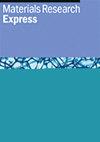Optimization of electrical discharge machining parameters for enhanced performance on inconel 718 using Cu-Ni-B4C nanocomposite electrodes and advanced modeling techniques
IF 2.2
4区 材料科学
Q3 MATERIALS SCIENCE, MULTIDISCIPLINARY
引用次数: 0
Abstract
This paper investigate into the complex field of electrical discharge machining (EDM) to improve material removal rate (MRR), electrode wear rate (EWR), and surface roughness (SR) for the machining of Inconel 718, a difficult-to-machine superalloy. The effects of discharge current, pulse duration, and pulse interval on machining performance were assessed through experiments. Response surface methodology (RSM) and artificial neural network (ANN) models, such as RNN, LSTM, and CNN, were used to optimize. Twenty runs of confirmation experiments were used to confirm the optimal process parameters found by the created models for better machining. For Inconel 718, the novel Cu-Ni-B4C nanocomposite electrode greatly enhanced EDM performance. The ideal configuration increased MRR while decreasing wear and surface roughness. Machined surfaces were inspected using SEM and EDAX analysis. With optimal settings of 50 μs pulse duration and 90 μs pulse interval, increasing current to 8 Amps increased MRR to 0.0118 g min−1, reducing EWR to 0.001 g min−1 and SR to 3.108 μm. Compared to the RNN, LSTM, and RSM models, the CNN model had the greatest R-squared (R2) score of 0.9999, suggesting greater MRR, EWR, and SR prediction.使用 Cu-Ni-B4C 纳米复合电极和先进建模技术优化放电加工参数,以提高 inconel 718 的性能
本文研究了复杂的电火花加工(EDM)领域,以提高材料去除率(MRR)、电极磨损率(EWR)和表面粗糙度(SR),用于加工 Inconel 718(一种难加工的超级合金)。通过实验评估了放电电流、脉冲持续时间和脉冲间隔对加工性能的影响。采用响应面方法(RSM)和人工神经网络(ANN)模型(如 RNN、LSTM 和 CNN)进行优化。通过 20 次确认实验来确认所创建模型的最佳工艺参数,以获得更好的加工效果。对于 Inconel 718,新型 Cu-Ni-B4C 纳米复合电极大大提高了放电加工性能。理想的配置提高了 MRR,同时降低了磨损和表面粗糙度。使用 SEM 和 EDAX 分析检测了加工表面。在脉冲持续时间为 50 μs 和脉冲间隔为 90 μs 的最佳设置下,将电流增加到 8 安培可将 MRR 提高到 0.0118 g min-1,将 EWR 降低到 0.001 g min-1,将 SR 降低到 3.108 μm。与 RNN、LSTM 和 RSM 模型相比,CNN 模型的 R 平方 (R2) 得分最高,为 0.9999,表明其对 MRR、EWR 和 SR 的预测能力更强。
本文章由计算机程序翻译,如有差异,请以英文原文为准。
求助全文
约1分钟内获得全文
求助全文
来源期刊

Materials Research Express
MATERIALS SCIENCE, MULTIDISCIPLINARY-
CiteScore
4.50
自引率
4.30%
发文量
640
审稿时长
12 weeks
期刊介绍:
A broad, rapid peer-review journal publishing new experimental and theoretical research on the design, fabrication, properties and applications of all classes of materials.
 求助内容:
求助内容: 应助结果提醒方式:
应助结果提醒方式:


